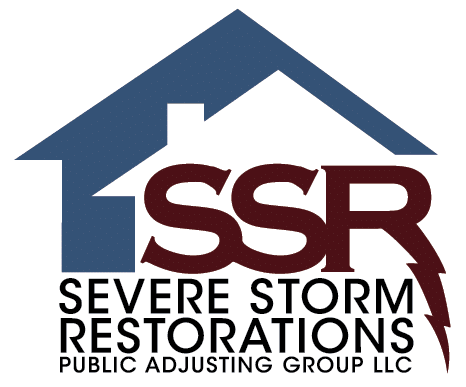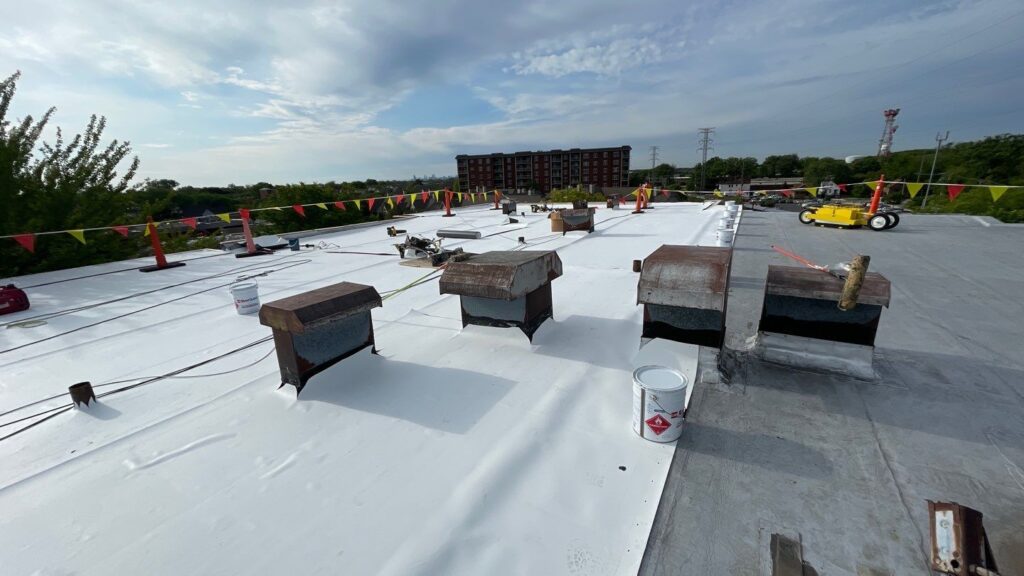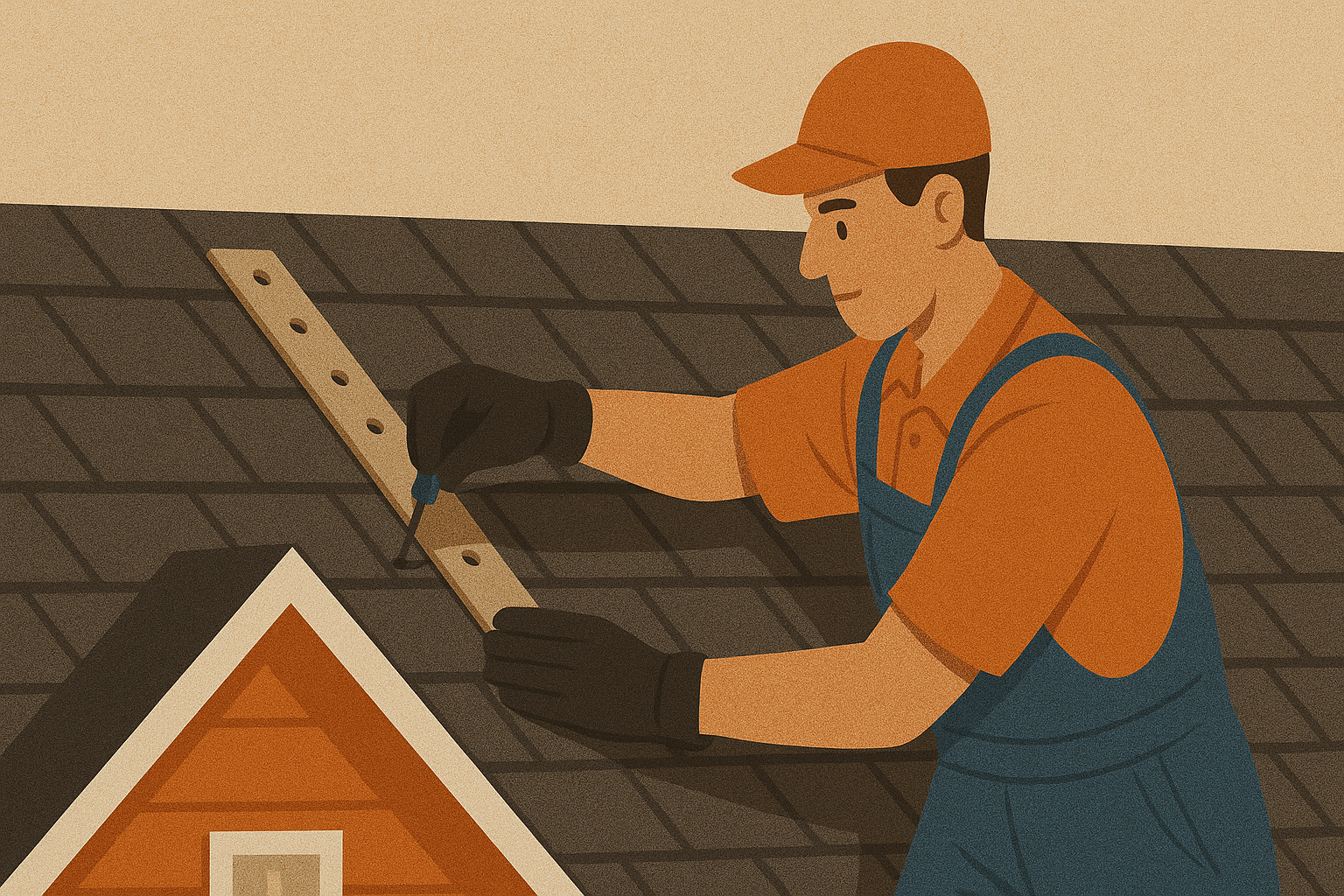Proper roof ventilation is a vital but often underestimated aspect of maintaining a healthy and long-lasting roof. Ventilation systems in the attic and roof create a steady airflow that balances temperature and humidity levels. This process prevents premature wear and tear on roofing materials, preserves structural integrity, and enhances overall energy efficiency.
When a roof lacks sufficient ventilation, it becomes vulnerable to a host of problems. Moisture buildup can lead to mold and mildew, while trapped heat accelerates the deterioration of shingles and underlayment. Over time, these issues can result in costly repairs or even require a full roof replacement.
In this guide, we’ll take a closer look at why roof ventilation is essential, the mechanisms that make it effective, and the significant benefits it provides. Additionally, we’ll offer practical tips to ensure your ventilation system functions optimally, helping you protect your roof and maintain a comfortable and efficient home environment.
What Is Roof Ventilation?
Roof ventilation is a critical system designed to maintain a balanced and healthy environment within your attic or roof cavity. It works by allowing air to circulate freely, ensuring that the temperature and moisture levels inside the attic are in harmony with the outdoor conditions. This balance prevents the buildup of heat and humidity, which can otherwise cause significant damage to your roof and home.
A typical roof ventilation system comprises two main components: intake vents and exhaust vents. Intake vents are usually located at the eaves or soffits, allowing cool air to enter the attic. Exhaust vents, situated near the ridge or peak of the roof, enable warm, humid air to escape. Together, these vents create a continuous flow of air, effectively ventilating the space.
By facilitating proper airflow, roof ventilation helps regulate indoor conditions, preventing the formation of mold, mildew, and structural damage caused by excessive moisture. Additionally, it keeps the roof cool, reducing the strain on roofing materials and enhancing their lifespan. This process is especially crucial in extreme climates, where temperature fluctuations and humidity levels can be more pronounced.
Why Roof Ventilation Is Crucial
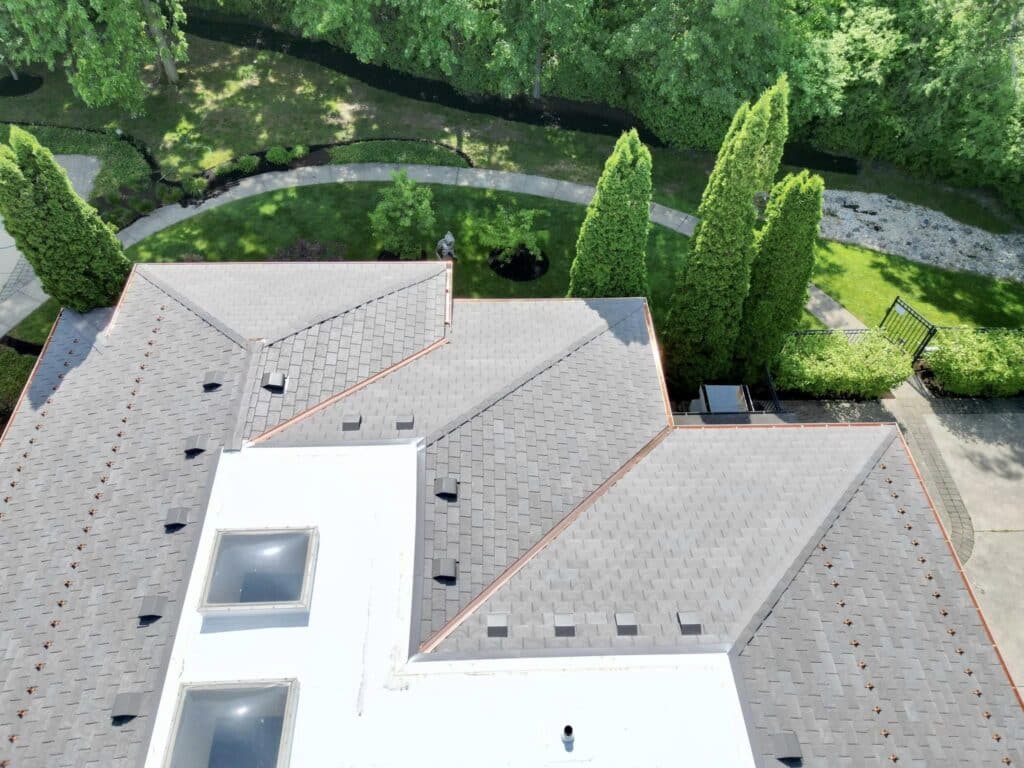
Proper roof ventilation is a cornerstone of maintaining the structural integrity of your home. It works to balance temperature and moisture levels, ensuring that your roof remains in optimal condition and reducing the risk of costly damage. This system serves several essential functions that directly impact the longevity and efficiency of your roof.
1. Temperature Regulation
Attic temperatures can soar during the summer, often exceeding outdoor temperatures by a significant margin. This trapped heat forces your home’s cooling system to work harder, driving up energy bills and straining HVAC equipment. Proper ventilation provides an escape route for hot air, preventing excessive heat buildup and maintaining a cooler attic.
In the winter, ventilation prevents warm, moist air generated from living spaces from rising into the attic. Without an outlet, this moisture can condense on cold surfaces and freeze, leading to ice dam formation and potential structural issues. By regulating attic temperatures year-round, ventilation helps protect your roof from seasonal stress.
2. Moisture Control
Everyday activities such as cooking, showering, and doing laundry release moisture into the air. Without proper roof ventilation, this moisture can become trapped in the attic, creating a damp environment that fosters mold and mildew growth. Over time, excessive moisture can seep into wooden beams and other structural components, leading to wood rot and weakening the roof’s integrity.
By allowing humid air to escape, ventilation reduces the risk of moisture-related problems. This not only protects the structural elements of your home but also creates a healthier indoor environment by minimizing the growth of allergens like mold.
3. Prolonging Roof Materials
High levels of heat and humidity in the attic can accelerate the deterioration of roofing materials. Shingles can curl or crack, the underlayment can weaken, and other components may degrade prematurely. Ventilation alleviates this stress by keeping the attic environment cooler and drier, preserving the quality of your roofing materials.
By reducing thermal and moisture-related stress, proper ventilation extends the lifespan of your roof, saving you money on repairs and replacements in the long run. Whether your roof is made of asphalt shingles, metal, or tile, a well-ventilated attic plays a crucial role in maintaining its durability and performance.
The Benefits of Roof Ventilation
1. Preventing Mold and Mildew Growth
Moisture buildup in an improperly ventilated attic creates the perfect environment for mold and mildew to flourish. Mold spores thrive in damp, warm conditions, and once they take hold, they can spread rapidly through your attic and into your living spaces. This can lead to a host of respiratory problems, particularly for those with allergies or asthma, and significantly compromise indoor air quality. Proper roof ventilation helps keep moisture levels in check, creating a dry environment where mold and mildew cannot thrive.
2. Avoiding Structural Damage
Excessive moisture doesn’t just affect air quality—it can also wreak havoc on your home’s structural integrity. Wooden supports, rafters, and decking are particularly susceptible to rot when exposed to prolonged dampness. Over time, this can weaken the roof’s framework, increasing the risk of sagging or even collapse in extreme cases. By promoting airflow, ventilation keeps the attic dry, preventing moisture from accumulating and preserving the strength of your roof’s structural components.
3. Enhancing Energy Efficiency
A poorly ventilated attic can act like an oven in the summer, trapping heat that radiates down into your living spaces. This forces your HVAC system to work overtime to maintain a comfortable indoor temperature, leading to higher energy bills and unnecessary wear on your cooling equipment. Roof ventilation allows hot air to escape, reducing attic temperatures and easing the burden on your air conditioning system. In winter, ventilation also prevents warm air from lingering in the attic, enhancing insulation performance and maintaining energy efficiency year-round.
4. Preventing Ice Dams
In colder climates, the lack of proper roof ventilation can contribute to one of winter’s most damaging problems: ice dams. When warm air escapes into the attic and heats the roof, snow on the roof melts and flows down to the eaves, where it refreezes. This creates blockages of ice, known as ice dams, which can cause water to back up under shingles and into your home. Ice dams can damage gutters, roofing materials, and even interior walls and ceilings. Proper ventilation helps maintain consistent roof temperatures, preventing the conditions that lead to ice dam formation and protecting your home from winter weather damage.
How Roof Ventilation Works
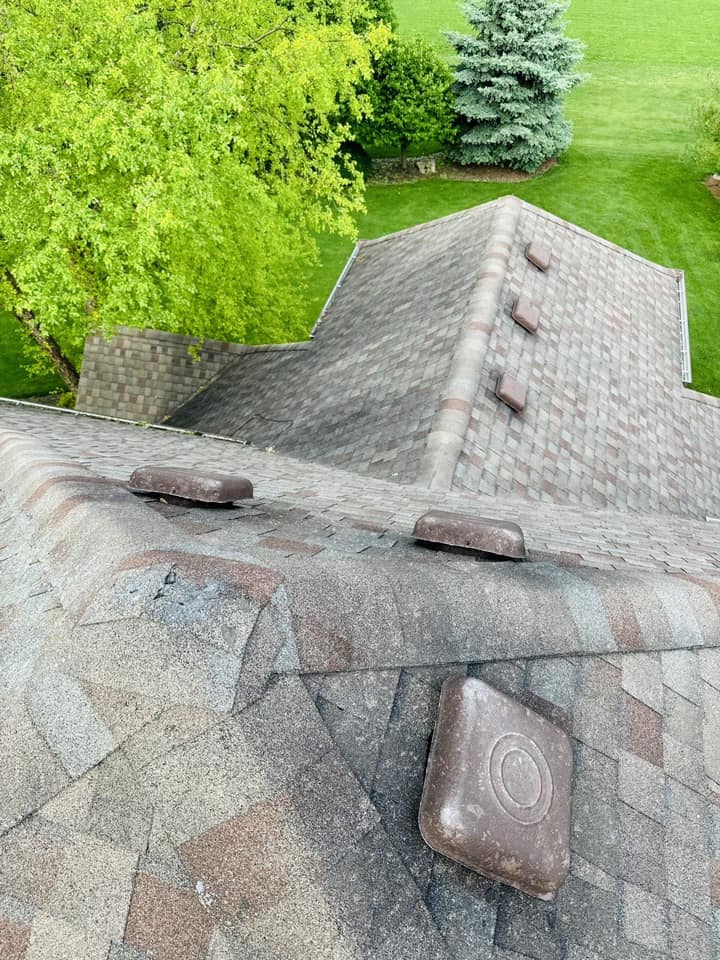
Effective roof ventilation relies on the natural principles of air movement. Warm air, which is lighter, naturally rises and exits the attic through exhaust vents located near the roof’s peak. Meanwhile, cooler air enters the attic through intake vents positioned at the soffits or eaves, creating a continuous cycle of airflow. This equilibrium helps regulate attic temperature and moisture levels, ensuring the roof and supporting structures remain in good condition year-round.
Types of Roof Ventilation Systems
1. Ridge Vents
Ridge vents are installed along the highest point of the roof, running the length of the ridge. These vents allow hot air to escape efficiently while blending seamlessly into the roofline for a discreet appearance. Ridge vents are particularly effective when paired with soffit vents, creating a balanced ventilation system that promotes continuous airflow.
2. Soffit Vents
Soffit vents are located beneath the eaves of the roof and serve as the primary intake point for cooler air. They play a vital role in maintaining the airflow needed for effective roof ventilation. Properly placed soffit vents ensure a steady supply of fresh air into the attic, working in tandem with exhaust vents to create a healthy ventilation cycle.
3. Gable Vents
Gable vents are mounted on the sides of the attic, typically near the peaks of the gable walls. These vents enable cross-ventilation by allowing air to flow horizontally through the attic. While not as commonly used as ridge and soffit vents, gable vents are an excellent solution for homes with limited ridge space or unique architectural designs.
4. Powered Vents
Powered vents, which can be electric or solar-powered, actively move air out of the attic. These vents are particularly useful for larger attics or homes in areas where natural airflow is insufficient. Powered vents can provide consistent ventilation regardless of weather conditions, making them an excellent choice for ensuring optimal attic airflow.
5. Turbine Vents
Turbine vents use wind power to draw hot air out of the attic. The spinning motion of the turbine creates a suction effect, effectively expelling warm air. These vents are cost-effective and eco-friendly, relying solely on wind energy to function. However, they require consistent wind to be most effective.
By understanding the different types of roof ventilation systems and how they work, homeowners can choose the most suitable option for their property, ensuring proper airflow and preventing potential roofing issues.
Signs of Poor Roof Ventilation
Identifying Inadequate Ventilation Early
Spotting the signs of poor roof ventilation is crucial to preventing significant damage to your home. When ventilation issues are addressed promptly, you can avoid costly repairs and ensure your roof remains in excellent condition.
Temperature Imbalances
Inconsistent temperatures throughout your home, such as rooms that are unusually hot in the summer or cold in the winter, may indicate poor roof ventilation. Without proper airflow in the attic, trapped heat during warmer months and cold air seepage during cooler months can lead to discomfort and higher energy costs.
Moisture Issues
Excess moisture in the attic is a key sign of inadequate ventilation. Look for condensation on windows, wet or damp insulation, or water stains on ceilings and walls. Trapped moisture can damage structural components, promote mold growth, and reduce the effectiveness of your insulation.
Mold Growth
Mold thrives in damp, poorly ventilated environments, making it a common problem in attics with inadequate airflow. Black or green mold patches on wooden beams or other attic surfaces are clear signs of trouble. Beyond structural concerns, mold poses health risks, including respiratory issues and allergic reactions.
Ice Dams
During winter, ice dams along the edges of your roof can form when trapped heat in the attic causes snow to melt and refreeze at the eaves. These ice dams can block water drainage, leading to leaks, shingle damage, and structural issues. Proper ventilation helps maintain a consistent roof temperature to prevent ice dam formation.
Peeling Paint
Excess attic moisture can seep into the walls and exterior surfaces, causing paint to bubble, crack, or peel. While this may seem like a cosmetic issue, it often indicates deeper problems with humidity control and airflow in the attic.
Shingle Damage
If your shingles appear warped, cracked, or prematurely aged, poor ventilation might be the culprit. High attic temperatures and trapped moisture accelerate the deterioration of roofing materials, reducing their effectiveness in protecting your home from the elements.
By recognizing these warning signs, you can take proactive measures to improve your roof’s ventilation system. Regular inspections and timely maintenance are essential to safeguarding your home against the long-term effects of inadequate ventilation.
The Risks of Poor Ventilation
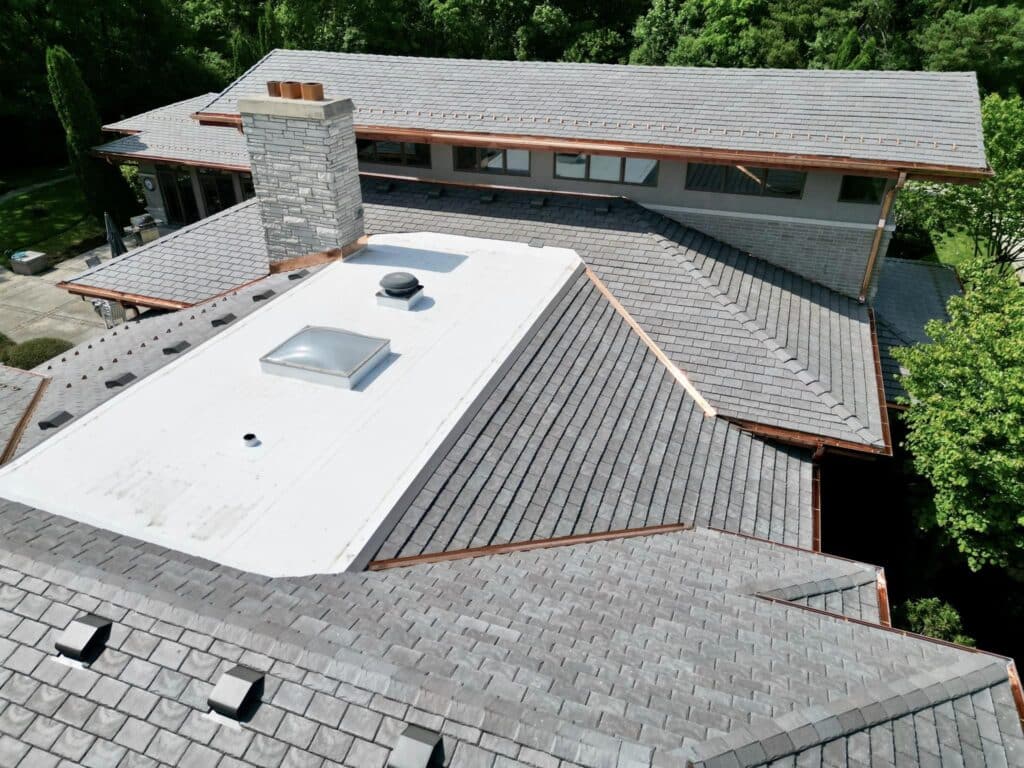
Failing to maintain proper ventilation can lead to a host of problems that affect not only your roof but also your home’s overall safety, comfort, and energy efficiency. Understanding these potential issues highlights the importance of a well-ventilated roofing system.
Premature Roof Aging
Without adequate roof ventilation, heat and moisture can accumulate in the attic, accelerating the deterioration of roofing materials. Shingles may warp, crack, or blister, and underlayment can weaken over time. This premature aging reduces the lifespan of your roof, often requiring costly repairs or a full replacement much sooner than expected.
Structural Damage
Excess moisture trapped in the attic can lead to rotting wood, rusted nails, and weakened roof supports. Over time, this structural damage compromises your roof’s ability to bear weight, especially during heavy snow or storms, increasing the risk of collapse. Addressing ventilation issues promptly can prevent this kind of costly and hazardous damage.
Increased Energy Costs
Poor roof ventilation allows heat to build up in the attic during summer months, forcing your HVAC system to work overtime to maintain comfortable indoor temperatures. In winter, trapped heat can cause uneven heating, leading to inefficiencies. These factors result in significantly higher energy consumption and utility bills, impacting your household budget.
Health Risks
A poorly ventilated attic provides the perfect environment for mold and mildew to grow, fueled by excess humidity. These fungi can spread quickly, releasing spores that can trigger allergies, asthma, and other respiratory issues. Prolonged exposure to mold can also lead to more serious health complications, particularly for individuals with preexisting conditions or weakened immune systems.
By prioritizing proper roof ventilation, you can avoid these detrimental effects and ensure the longevity, efficiency, and safety of your home. Regular inspections and proactive maintenance are key to keeping your ventilation system functioning optimally.
How to Ensure Proper Roof Ventilation
Maintaining an effective ventilation system requires proactive care and attention. Implementing these best practices can help ensure your roof remains well-ventilated, protecting your home and extending your roof’s lifespan.
1. Conduct Regular Inspections
Inspect your attic and roofing system at least twice a year, preferably in spring and fall. Look for common signs of poor ventilation, such as moisture buildup, water stains, mold, or damaged vents. Pay close attention after extreme weather events, as heavy rains or storms can exacerbate ventilation issues. Regular inspections allow you to catch problems early and address them before they escalate.
2. Install the Right Ventilation System
Every roof is unique, and choosing the right ventilation system is crucial for optimal performance. Factors like roof type, climate, and home size play a significant role in determining the best solution. Consult a professional roofer to evaluate your property and recommend the most suitable system, whether it’s ridge vents, soffit vents, or powered ventilation. Proper installation is essential for maximizing airflow and efficiency.
3. Maintain Your Vents
Keep your vents clean and free of debris to ensure proper airflow. Over time, leaves, dust, and dirt can block vents, reducing their effectiveness. Regularly check intake and exhaust vents for obstructions and clean them as needed. This simple step can significantly improve the overall performance of your ventilation system and prevent moisture buildup.
4. Address Insulation Issues
Insulation works hand-in-hand with ventilation to regulate temperature and humidity in your attic. Poor or insufficient insulation allows warm air to escape into the attic, disrupting the ventilation system’s ability to balance airflow. Check your attic for gaps, compressed areas, or deteriorating insulation. Adding or replacing insulation as necessary ensures your attic stays at a consistent temperature, reducing the risk of ice dams, condensation, and energy loss.
5. Seal Air Leaks
Air leaks around attic hatches, pipes, vents, and recessed lights can allow warm, moist air to escape into the attic, compromising roof ventilation. Use caulking, weatherstripping, or spray foam to seal these gaps effectively. Sealing air leaks not only improves ventilation efficiency but also reduces energy consumption, as less conditioned air escapes from your living spaces.
By following these steps, you can maintain a healthy and efficient ventilation system, protecting your home from damage and ensuring long-term energy savings. Proactive maintenance and professional guidance are key to achieving optimal results.
The Cost of Ignoring Roof Ventilation

Failing to address ventilation issues can result in a cascade of problems, each with financial and practical implications. While roof ventilation may seem like a minor detail, its impact on your home’s health and your wallet is substantial.
Roof Repairs
One of the most immediate consequences of poor ventilation is the damage it causes to your roof’s structure. Excess moisture trapped in the attic creates an ideal environment for rot and mold, which can compromise the integrity of wooden supports, decking, and shingles. Over time, this can lead to extensive and expensive structural repairs. What could have been avoided with simple ventilation improvements might instead result in thousands of dollars in restoration costs.
Increased Energy Bills
Poor ventilation disrupts the balance of temperature within your attic and home, forcing your HVAC system to work harder to maintain comfort. During summer, heat trapped in an unventilated attic radiates into your living spaces, increasing cooling costs. In winter, warm, moist air escaping into the attic can cause insulation to lose its effectiveness, driving up heating bills. These inefficiencies add up, leading to significantly higher energy expenses over time.
Health Costs
Mold and mildew thrive in poorly ventilated attics, releasing spores that can spread throughout your home. Exposure to mold can trigger respiratory issues, allergies, and other health problems, particularly in individuals with asthma or weakened immune systems. Addressing mold-related illnesses can result in medical expenses that could have been avoided with proper ventilation. Moreover, the cost of mold remediation can be substantial if the issue spreads extensively.
The Value of Investing in Ventilation
Investing in a proper roof ventilation system is a proactive measure that can save you from these costly consequences. Compared to the expenses of roof repairs, inflated energy bills, and health-related costs, the price of installing or upgrading ventilation is minimal. The long-term benefits—enhanced roof durability, energy efficiency, and a healthier living environment—far outweigh the initial investment.
Ensuring adequate roof ventilation is not just about avoiding problems; it’s about creating a more comfortable, efficient, and sustainable home. Taking action now can spare you the stress and expense of dealing with preventable issues in the future.
Ventilation Solutions for Different Roof Types
Every roof type has unique characteristics that require specific ventilation solutions to ensure optimal airflow and protection. Here’s how ventilation can be adapted to accommodate different roof designs:
Flat Roofs
Flat roofs present a distinct challenge due to their minimal slope, which limits natural air circulation. Powered vents or turbine vents are essential in these cases, actively promoting airflow to prevent heat and moisture buildup. These systems effectively remove stagnant air, reducing the risk of condensation, mold, and water damage. Without adequate ventilation, flat roofs can trap moisture, leading to long-term structural issues and a shortened lifespan.
Pitched Roofs
Pitched roofs benefit from ridge and soffit vents, which work together to create a natural airflow cycle. Cool air enters through soffit vents located along the eaves, while warm air escapes through ridge vents at the roof’s peak. This continuous flow regulates temperature and humidity, preventing issues like ice dams in winter or excessive heat buildup in summer. Pitched roofs often have ample attic space, making this combination an efficient and low-maintenance solution for ventilation.
Metal Roofs
Metal roofs are highly durable but require specialized venting solutions to address condensation, a common issue with this material. Without proper ventilation, temperature fluctuations can cause moisture to collect on the underside of the metal panels, leading to corrosion and compromised insulation. Ridge vents combined with vapor barriers and proper insulation are critical for maintaining temperature balance and preventing condensation. For metal roofs on flat or low-slope structures, powered vents may also be necessary to ensure sufficient airflow.
By understanding the unique needs of different roof types, property owners can implement the most effective ventilation systems, ensuring longevity, efficiency, and protection against common roofing problems.
Conclusion
Roof ventilation is a complex system that requires careful planning and installation. Hiring a professional roofing contractor ensures your ventilation system is correctly designed to meet your home’s specific needs. Experts can assess your current setup, recommend upgrades, and perform maintenance to maximize efficiency.
Proper roof ventilation is essential for prolonging the lifespan of your roof and maintaining the overall health of your home. By preventing mold growth, rot, and energy inefficiency, a well-ventilated roof protects both your property and your wallet.
Don’t wait until problems arise—invest in roof ventilation today to enjoy a safer, more energy-efficient, and long-lasting roofing system. For professional guidance, consult a trusted roofing contractor to ensure your home is equipped with the best ventilation solution.
